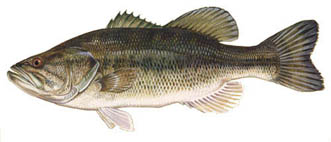Largemouth Bass (Micropterus salmoides)

Food Value
Fish that meet size limits are usually good if skinned.
Distinguishing Features
Upper jaw extends past rear margin of eye. Deeply notched dorsal fin. Body usually dark and blotchy with longitudinal bands on sides.
Size
Averages 1-3 pounds but up to 6 pounds is also fairly common. Rarely larger than 10 pounds in California. World record: 22 pounds, 4 ounces.
Preferred Habitat
Warm, shallow waters at around 80 degrees F. Will hide in shelter or vegetation to wait passing prey. Prefers live bait.
Smallmouth Bass (Micropterus dolomieui)
Food Value
Excellent
Distinguishing Features
Dark vertical barring on sides. Upper jaw does not extend past eye and dorsal fin is not deeply notched.
Size
Averages 1-2 pounds but up to 4 pounds is also fairly common. World record: 10 pounds, 14 ounces.
Preferred Habitat
Prefer colder, swifter water than Largemouth Bass, around 70 degrees F. More likely to be found around rocks and submerged trees and logs.
Striped Bass (Morone saxatilis)
Food Value
Very good. Light, rich flesh.
Distinguishing Features
Usually dark green to dark gray color above, silver belly. Seven to eight stripes on sides reaching from head to tail.
Size
Averages 5-20 pounds with 50 pound fishes possible. Freshwater world record: 67.8 pounds.
Preferred Habitat
Like deep, cool to cold waters. Will hide in deeper areas of lakes. Best to try trolling or drifting. Can often find a school of Striper's when they are striking at a school of shad or other fish near the surface. This is called a " boil".
Black Crappie (Pomoxis nigromaculatus)
Food Value
Excellent
Distinguishing Features
Green to dark gray on back, white to yellow on sides. Sides have spots and wavy, broken lines. Tail and rear fins are large and fan shaped.
Size
Average between 8 ounces and 2 pounds. Can reach up to 4 pounds. World Record: 4 pounds, 8 ounces.
Preferred Habitat
Prefers cleaner water than the White Crappie. Usually found in and around brushy areas.
White Crappie (Pomoxis annularis)
Food Value
Excellent
Distinguishing Features
Lighter color than Black Crappie. More symetrical markings arranged in vertical bars.
Size
Most weigh about 12 ounces but 1 to 2 pounds is common. Can reach 3 pounds. World Record: 5 pounds, 3 ounces.
Preferred Habitat
Prefer murkier water than Black Crappie but usually found near each other. Like to be close to cover including logs, brush piles, or vegetation.
Bluegill (Lepomis macrochirus)
Food Value
Good to Excellent. Larger fish should be skinned.
Distinguishing Features
Small mouth. Black spot located just behind gill and sometimes another on the base of the dorsal fin. Body olive green with five to seven verticle bands and orange or light colored belly. Fish is usually taller than wide.
Size
Averages up to half pound. Some strains can reach 4 pounds. World Record: 4 pounds, 12 ounces.
Preferred Habitat
Prefers lots of shelter, often found under docks or in dense vegetation.
Redear Sunfish (Lepomis microlophus)
Food Value
Excellent. Thick, tasty fillets.
Distinguishing Features
Bright red spot at gill flap. Olive to bluish color on sides and bright yellow belly. Some have dark verticle bars on side.
Size
Average half pound to one pound. Up to 2 pounds are also common. Can reach 4 pounds. World record: 5 pounds, 7 ounces.
Preferred Habitat
Shallow, weedy water.